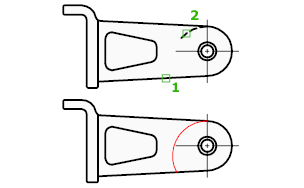Mastering the EXTEND Command in AutoCAD: A Comprehensive Guide

AutoCAD, the renowned computer-aided design (CAD) software developed by Autodesk, provides a vast array of tools and commands for creating precise and detailed drawings. Among these tools, the EXTEND command stands out as a fundamental feature for extending objects to meet the edges of other objects within a drawing. In this comprehensive guide, we delve deep into the intricacies of using the EXTEND command in AutoCAD, exploring various methods, techniques, and best practices for optimal utilization.
Understanding the EXTEND Command in AutoCAD:
The EXTEND command in AutoCAD allows users to extend lines, arcs, polylines, and other geometric entities to meet the edges of other objects or boundaries within a drawing. It is a versatile tool for editing and modifying objects, facilitating precise adjustments and cleanup of drawings. The EXTEND command enables users to elongate objects to desired endpoints, enhancing clarity and accuracy in the drawing.
Using the EXTEND Command:
AutoCAD offers multiple methods for using the EXTEND command to edit objects in drawings:
1. Command Line Input:
The most straightforward method for using the EXTEND command is through command line input. To extend objects using the command line, follow these steps:
- Type “EXTEND” in the command line and press Enter to activate the EXTEND command.
- Select the boundary objects to which you want to extend other objects by clicking on them or selecting them from the drawing area.
- Select the objects you want to extend by clicking on them or selecting them from the drawing area.
- Press Enter to complete the extension operation.
2. Ribbon Interface:
AutoCAD’s Ribbon interface provides a graphical user interface for accessing commands and tools. To use the EXTEND command from the Ribbon interface, follow these steps:
- Navigate to the Home tab on the Ribbon.
- Click on the Modify panel to expand it.
- Click on the Extend icon to activate the EXTEND command.
- Select the boundary objects and the objects you want to extend using the options provided in the Ribbon interface.
- Click OK or press Enter to complete the extension operation.
3. Toolbar or Tool Palette:
Users can also access the EXTEND command from toolbars or tool palettes for quick access and convenience. Simply click on the Extend tool icon in the toolbar or tool palette to activate the EXTEND command and follow the prompts to edit objects.
Key EXTEND Command Options:
When using the EXTEND command in AutoCAD, users can specify various options and parameters to customize the extension operation according to their requirements. Key options include:
- Boundary Objects: Specify the boundary objects or edges to which other objects will be extended.
- Objects to Extend: Select the objects you want to extend, elongating them to meet the boundary objects.
- Multiple Selection: Select multiple boundary objects and objects to extend simultaneously, streamlining the editing process for complex drawings.
Advanced Techniques:
In addition to basic extension methods, AutoCAD offers advanced techniques and tools for enhancing the EXTEND command and efficiency:
- Extension with Grips Editing: Use grips editing to extend objects interactively by clicking and dragging grip points, providing a visual and intuitive method for adjusting object endpoints.
- Extension with Trim Mode: Apply the EXTEND command with the Trim mode option to extend objects and automatically trim them to the boundary objects simultaneously, combining extension and trimming operations in one step.
- Extension with Selection Filters: Use selection filters to refine object selection for extension, allowing for targeted extension of specific object types or layers within the drawing.
Best Practices:
To achieve optimal results when using the EXTEND command in AutoCAD, it’s essential to adhere to the following best practices:
- Plan and Preview: Before extending objects, carefully review the drawing and plan the desired extension boundaries, considering factors such as object relationships and design intent.
- Use Consistent Parameters: Maintain consistency in extension parameters such as boundary objects and object selection to ensure uniformity and accuracy in the extension operation.
- Optimize Object Selection: Select objects efficiently for extension by using selection sets, filters, or object grouping, streamlining the extension operation and minimizing errors.
- Review and Verify: Review extended objects for accuracy and completeness before finalizing drawings, verifying endpoints and object relationships to ensure compliance with design specifications.
Conclusion:
In conclusion, mastering the EXTEND command in AutoCAD empowers designers and drafters to edit and modify objects with precision and efficiency. By understanding the various methods, options, and best practices for using the EXTEND command, users can extend objects with ease, facilitating cleanup and refinement of drawings. With AutoCAD’s versatile tools and features, designers can achieve efficient extension operations and enhance productivity in their drawings and designs.




